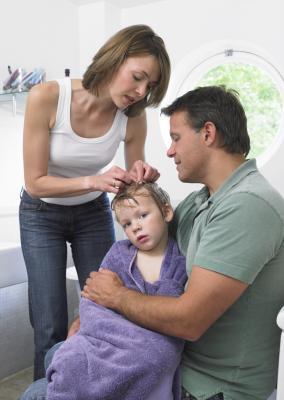Lice feed on humans by biting into their scalp or skin and sucking out blood. It sounds gory, but often the only sign that you or your child has body or head lice is an unpleasant, itchy feeling on the scalp or skin. Body lice and head lice are two different types of the parasitic insect.
Types
Head lice live in your hair. School-age children are most likely to get head lice, which spread from close contact, such as by two children putting their heads together while playing or working on a school assignment. The lice lay their eggs on the strands of hair, usually near the scalp. Body lice live on clothing and lay their eggs in the seams of the clothes. They travel from the clothes to a person’s body to feed, according to MayoClinic.com, while head lice travel from the hair to the scalp. Body lice usually afflict people who live in close, unclean quarters, such as those in a war camp or homeless shelter.
Symptoms
The most obvious symptom of an lice infestation is itching in the afflicted area. Body lice tend to make the armpits and waist area itch while head lice cause scalp itching. You may also notice red bumps on the scalp or shoulders from the lice bites. You may also be able to spot the lice on your child’s scalp, particularly near the ears and neck or see body lice on a person’s clothing or in their bed linens.
Problems with Lice
Itching skin usually makes a person want to scratch. Some children with head lice may scratch their scalp so much that they break the skin, putting them at risk for a bacterial infection, according to MayoClinic.com. Body lice can carry diseases, such as typhus, which they can transfer to a person with their bites. If the lice are left untreated, they can cause the skin in the infested area to change color or become thicker.
Treating Lice
Usually, an over-the-counter shampoo designed to kill lice will treat the infestation of head lice. Washing clothing and bed linens in hot water with soap will kill body lice, as will taking a thorough bath. Sometimes, you may need to use lice shampoo to treat body lice as well. Some types of head lice are resistant to the shampoos, and so you may need to get a prescription shampoo from your doctor. If a very young child has head lice, you can try to remove the lice by combing her hair while wet.
Preventing Lice
In most cases, effectively treating head or body lice is the best form of prevention, since your child will not be able to spread the infestation to others. If your child has lice, make sure you alert his school, so that they can screen other children and alert other parents. Prevent further infestations by telling your child not to share his hats or combs with friends. Keep a close eye on your child’s scalp and clothing so that you can quickly treat any future infestations.





